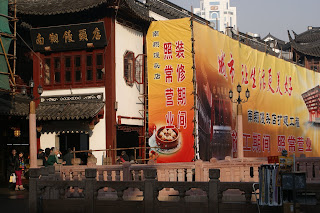Source from Wikipedia
Yuyuan Garden is a famous classical garden located in Anren Jie, Shanghai. The garden was finished in 1577 by a government officer of the Ming Dynasty (1368-1644) named Pan Yunduan. Yu in Chinese means pleasing and satisfying, and this garden was specially built for Pan's parents as a place for them to enjoy a tranquil and happy time in their old age
People's Square






Shanghai's Dumpling-Xiao Long Bao
A notable Shanghai delicacy is the Xiao Long Bao, sometimes known as Shanghai Dumplings in English-speaking countries [2] Xiao Long Bao, or "small steamer bun" (literally translated) as mentioned above, is a type of steamed bun that is filled with pork (most commonly found) or minced crab, and soup. Although it appears delicate, a good xiao long bao is able to hold in the soup until the xiao long bao is bitten. They are steamed in bamboo baskets and served with vinegar and in some places, shredded ginger. A common way of eating the Xiao Long Bao is to bite the top off, suck all the soup, then dipping it in vinegar before eating
the soup, then dipping it in vinegar before eating





Shanghai XinTiandi
Located in the center of Shanghai City south of Huaihai Zhong Lu, Shanghai Xin Tian Di has become an urban tourist attraction that holds the historical and cultural legacies of the city. Shanghai Xin Tian Di is a fashionable pedestrian street composed of Shikumen and modern architecture style.Shanghai Xin Tian Di is unique because of its concept of construction. It retains the antique walls, tiles and exterior of the Shikumen housing of old Shanghai. On the other hand, its interior embodies a totally different world of international gallery, bars and cafes, boutiques or theme restaurants. When you walk into Xin Tian Di, you will get the taste both of Shanghai in the 1920's and the sonic modern lifestyle of urbanites of the 21st century










Nanjing Road
China's premier shopping street, 3.4-mile-long Nanjing Road, starts at the Bund in the east and ends in the west at the junction of Jingan Temple and Yan'an West Street. Today Nanjing Road is a must-see metropolitan destination attracting thousands of fashion-seeking shoppers from all over the world. Today over 600 businesses on Nanjing road offer countless famous brands, superior quality, and new fashions. KFC, McDonald's, Pizza Hut, and other world-famous food vendors line both sides of the street. Upscale stores include Tiffany, Mont Blanc, and Dunhill. In addition, approximately a hundred traditional stores and specialty shops still provide choice silk goods, jade, embroidery, wool, and clocks.
People's Square (simplified Chinese: 人民广场; traditional Chinese: 人民廣場; pinyin: Rénmín Guǎngchǎng) is a large public square adjacent to Nanjing Road in the Huangpu District of Shanghai, China.











Night Scenery Nanjing Road
Open-air bars, abstract sculptures, and lingering sounds from street musicians enhance evening strolls. A trackless sightseeing train provides a comfortable tour of the night-transformed pedestrian street. Flashing neon signs illuminate the magnificent buildings and spangle the night skyline of this lively city.





Skyscrapers in Pudong

The Oriental Pearl Tower (Chinese: 东方明珠塔; pinyin: Dōngfāng Míngzhūtǎ, Official Name: 东方明珠电视塔) is a TV tower in Shanghai, China. The Oriental Pearl Tower is located at the tip of Lujiazui in the Pudong district, by the side of Huangpu River, opposite The Bund of Shanghai



The Bund - Situated along the western bank of the Huangpu River, the Bund is thought to be the symbol of the city. It is a 4 kilometer-long waterfront. The Bund, retaining an air of the past, is a glimpse of the city's roaring past. 52 buildings of different architectural styles such as Baroque, Gothic, Romanesque, Chinese and Renaissance erect on the bund. Therefore, it is also called “The Museum of International Architecture”. The European buildings contrast finely with skyscrapers on the east bank of the Huangpu River






The Jin Mao Tower (simplified Chinese: 金茂大厦; traditional Chinese: 金茂大廈; pinyin: Jīn Mào Dàshà; literally "Golden Prosperity Building") is an 88-story landmark supertall skyscraper in the Lujiazui area of the Pudong district of Shanghai, People's Republic of China. It contains offices and the Shanghai Grand Hyatt hotel. Until 2007 it was the tallest building in the PRC, the fifth tallest in the world by roof height and the seventh tallest by pinnacle height

The Shanghai World Financial Center (Abbr: SWFC; simplified Chinese: 上海环球金融中心; traditional Chinese: 上海環球金融中心; pinyin: Shànghǎi huánqiú jīnróng zhōngxīn) is a supertall skyscraper in Pudong, Shanghai, China. It is a mixed use skyscraper which consists of offices, hotels, conference rooms, observation decks, and shopping malls on the ground floors. Park Hyatt Shanghai is the hotel component containing 174 rooms and suites. It is the highest hotel in the world, surpassing the Grand Hyatt Shanghai on the 53rd to 87th floors of the neighboring Jin Mao Tower.[6]


Views taken from the 97th floor of the SWFC






